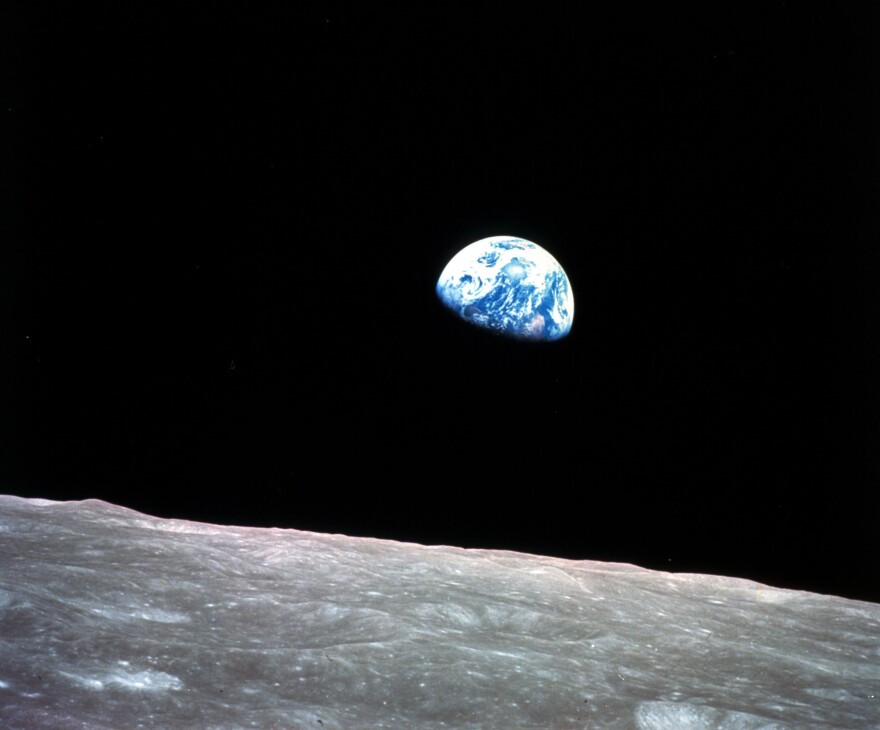Roger Launius is an aerospace historian and writer who’s worked for NASA and the Smithsonian. His new book is titled, “Apollo’s Legacy: Perspectives on the Moon Landings.” Launius discussed the work with KGOU’s Richard Bassett ahead of the 50th anniversary of the Apollo 11 Moon landing on July 20. Their conversation touched on Apollo's technological and photographic legacies, as well as efforts to preserve historical sites on the lunar surface, and how JFK repeatedly reached out to the USSR during the Cold War in hopes of going to the moon together.
Full On-Air Transcript:
(Launius and Bassett began by discussing some lasting impacts the technology created to get to the moon has had on the twenty-first century.)
Roger Launius: The story again I like to tell about this is about NASA's Mission Control Center. Everybody's seen the pictures of all of these people sitting at consoles with big screens up in the distance as a mission is going on. And that's where they control everything. Every city today has at least one of those Mission Control Centers monitoring its transportation grid, its electronics grids, its plumbing, its communication systems. All of those things are a part of how we manage a modern set of capabilities that are ubiquitous with us today.

Richard Bassett: Being a millennial ... myself. I think it's easy to sometimes take for granted some of the amazing images captured by the Apollo astronauts. I find it incredible to think that, you know, before 1968 during Apollo 8 nobody had seen a photograph of the Earth from above before. Tell us a little bit about that image and some of the other famous images from Apollo 11 that you wrote about in your book.
Launius: Well, I think there's a half a dozen or so really kind of path breaking images. And one of them is the Earthrise image from Apollo 8 where you see the lunar surface in the foreground, gray and lifeless, and hanging in the blackness of space in the distance is Earth. This blue and white marble, which we all know is teeming with life. Everything we've ever loved everything we've ever hated exists on that particular body. And it really did create an aha moment for all kinds of people as they saw that for the first time. You know you see that we are really on a spaceship ourselves. It's what the Earth is. And there aren't any lifeboats. And we better do a better job of taking care of it. And so the modern environmental movement really got a shot in the arm with that particular image. Another one that that I find in the same category is the boot print on the moon that Buzz Aldrin took a photograph of. And what is remarkable about that picture in my mind is that since there's almost no seismic activity on the moon and there's no atmosphere, no water, none of those sorts of things, that boot print will be there eons from now—long after we are planet hopping to other solar systems.

Bassett: With the possibility of going back to the moon, is anything being done to preserve those footprints?

Launius: So there's a number of activities along those lines to try to preserve the sites where human activity has taken place on the moon. And it's a tall order. There's not been any formal success yet in trying to protect those sites. But there's a number of entities that are pushing this. We think that there is, there may be some opportunity to pursue this further with the United Nations. The problem we've got is that no national entity has any jurisdiction over the moon. So we'll have to figure out how legally we might be able to preserve it.
Bassett: So your book has a chapter titled, Apollo and the Religion of Spaceflight. In it you write, "Apollo represented as much as anything else a spiritual quest, a purification of humanity, and a search for absolution and immortality." Can you unpackage that statement for us?
Launius: Yeah, sure. When you start thinking about spaceflight it has all the ingredients of sort of a religion. It has most importantly, a salvation theology associated with it. In most of our conceptions of religion here on Earth, there is a sense of an afterlife and becoming immortal. And that's true for spaceflight as well. Not for the individual, but for the, for humankind as a whole. So as we become a multi-planetary species and we move from place to place to place in the universe, we have the opportunity then to continue our species beyond. And that's not true if we stay on this planet. There is absolutely 100 percent certainty that we will become extinct as long as we remain on this planet. Now it may be billions of years in the future when the earth becomes consumed by a red giant that will be the Sun that expands. But at that point we better be somewhere else or we're extinct. And that's the best case scenario. There are of course more immediate threats to our survival as a species. And some of those we might do to ourselves like nuke each other or so foul the planet that we can't survive here. In which case we probably deserve to be extinct. But be that as it may, that salvation theology is a part of the idea of spaceflight and a part of what was behind Apollo as well.
Bassett: So Apollo's legacy, well a part of Apollo's legacy then is the technology created to get to the moon in the mid-20th century is integral to, you know, the long term survival of our species?
Launius: Absolutely.

As a community-supported news organization, KGOU relies on contributions from readers and listeners to fulfill its mission of public service to Oklahoma and beyond. Donate online, or by contacting our Membership department.







